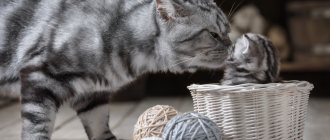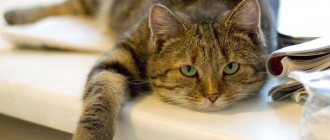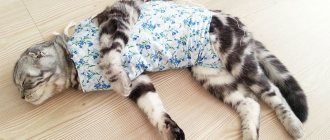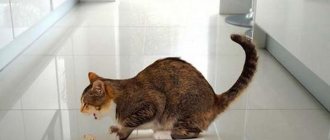As a rule, cats take care of each of their kittens from the first minutes of its life. But sometimes it happens that, for reasons that are not immediately clear to the owners, the domestic cat abandons the kittens.
If this happens, read on the website sympaty.net about what to do and how to produce cat offspring.
Possible problems for a cat after giving birth
- Hormonal imbalance leading to disruption of lactation. After childbirth, alarming symptoms often appear, consisting in the inability to process glucose. This leads to a state of shock. The condition improves after injection with insulin, but it is better to get tested and consult a veterinarian;
- Stressful state. It arises due to human intervention (intentional or accidental). For example, in the first hours after birth, kittens were picked up and moved or the nest was moved. A change of bedding or furnishings, or bright light could frighten the young mother. The cat may eventually take back her offspring. In this case, the owner should try to provide comfort and, as soon as the young mother calms down and finds a closed place, she needs to put a nest with kittens there.
- Birth of non-viable kittens. It also happens that the offspring are too numerous, and the mother cat, feeling a lack of milk, does not feed the weak (but potentially having a chance to survive) babies. In this case, the owner has to provide assistance in caring for the offspring;
- Complicated childbirth and its consequences - endometritis, mastitis, etc. A cat does not think about its offspring if it feels pain, it only cares about its own condition. Some animals in a state of “postpartum insanity” may crush, tear to pieces or eat their babies.
- Too early (by cat standards) birth and pregnancy. The animal does not reach puberty and becomes pregnant. But it does not want to raise its offspring further.
- Lack of calcium or eclampsia is a dangerous condition for a young mother, requiring injections with the appropriate microelement and observation of the animal.
It may turn out that the reason for the reluctance to feed is a weak condition. If the cat rests, it will gain strength and begin to fulfill its duties towards the offspring.
There is no need to panic; it is better to provide the nurse with a large volume of liquid - milk, broth and water. Kittens need warmth while their mother is away. You will need a heating pad in soft fabric, which is placed in the nest. The cat needs to be calmed down, caressed, and treated to something tasty by all means.
What's wrong with the cat? Possible reasons for abandonment of offspring
How to understand what is wrong with a cat and why she refused kittens? It is important to understand that cats very rarely abandon kittens, since they have highly developed instincts for caring for their offspring. You can understand the reasons by observing the young mother.
If a cat hisses, rushes at the kittens, tries to hit them with her paw or strangle them, most likely the babies were born prematurely and the young mother considers them unviable. In this case, it is useless to insist on the kittens being taken back; it is better to try to feed the babies yourself.
If a cat has given birth for the first time, she may refuse kittens due to severe stress. In this case, there is a chance to “persuade” the young mother to accept the offspring back. Keep a close eye on the cat, she will look for a more reliable shelter for her offspring. Once the cat finds shelter and settles down in it, do everything to move the nest closer to her. If necessary, move furniture, empty cabinets, but give the young mother the opportunity to choose what she considers a safe shelter for her offspring.
A cat may abandon kittens if her health or life is in danger. The most common cause of abandonment of offspring immediately after birth is eclampsia. This condition is life-threatening for the young mother, so it is necessary to contact a veterinarian. Postpartum eclampsia is eliminated by injections of drugs containing calcium.
If a cat has problems with the functioning of the hormonal system, alarming symptoms may appear immediately after birth. Most often, we are talking about the inability to process glucose, as a result of which the young mother falls into a state of shock. Shock can be relieved with insulin, however, be sure to contact your veterinarian for a more accurate diagnosis.
What should the owner do to get the cat to accept the kittens back?
First of all, contact a veterinarian and call him to your home. The specialist will make a diagnosis and recommend treatment. After this, the cat will calm down, the pain and discomfort will go away, and lactation will begin to recover. During the normal course of the birth process, the cat is provided with a dark and quiet place so that no one disturbs it and its offspring.
You should not touch the babies with ungloved hands - this can interrupt the smell that is familiar to the mother cat, and she will refuse to feed the babies. A cat that does not show the initiative to feed is affectionately seated next to the babies, petted and talked to, discreetly placing a kitten next to it. You can try to “mark” the kittens with the smell of their mother (a drop of milk or urine), sour cream or another favorite treat. So, by licking the treat, the cat will also lick the kitten.
If the above measures do not bear fruit, the babies have to be artificially fed. At the same time, we must not forget about the other functions of the mother - warming the babies, maintaining hygiene, maintaining a constant temperature in the nest (not lower than 26 degrees). The kittens' habitat is covered with a clean cloth or baby diapers that absorb moisture.
Important! The fabric to be covered must be soft and natural, not fray or stretch, and not serve as a source of static electricity.
Babies should be examined before and after feeding. If there are no alarming signs at first glance, do a light massage of the tummy and areas of the reproductive system. The massage is performed with a soft cotton sponge. The meaning of the procedure is to imitate cat licking. Without such imitation, kittens cannot empty their bladder and intestines, which is why they die. The intestines of a kitten that has not received colostrum are sterile.
If you feed kittens incorrectly, microflora develops in the intestines, contributing to digestive problems, indigestion and bloating. An artificial diet that is unsuitable for kittens can lead to the death of babies.
It is important to prepare for the birth of your pet by making, just in case, a list of necessary purchases for feeding the offspring.
This includes: a heating pad (it’s better if it’s electric). As a last resort, plastic bottles filled with heated water are used for heating; they need to be wrapped in terry cloth. You can also warm the kitten with your body by squeezing the baby close to you.
Milk replacers and formulas for kittens without a mother
Milk substitutes and formula can be used to feed kittens. Recently, veterinarians have not recommended using homemade products together, since there is a high chance of errors in dosage and preparation.
Regardless of the mixture you use, you need to make up the daily food intake based on the kitten’s weight:
- From birth to 7 days – 30 ml per 100 g. body weight.
- From 7 to 14 days – 35 ml per 100 g. body weight.
- From 14 to 21 days – 40 ml per 100 g. body weight.
- From 21 to 28 days – 45–48 ml per 100 g. body weight.
- From day 28 – at least 50–53 ml per 100 g. body weight.
Important! If your kitten is having difficulty swallowing or appears weak, it is most likely due to dehydration. The problem can be eliminated by using a small amount of rehydron solution to dilute the milk formula.
Industrial cat milk substitutes
Industrial cat milk substitutes are considered the optimal product for artificial feeding of kittens. When producing substitutes, the kittens' protein and fat content needs are taken into account.
Common brands of industrial cat milk replacers are:
- Katzenmilch – possible from day one.
- Hartz milk powder.
- Babycat Milk (Royal Canin) - according to the instructions, it is possible only from 2 months, but the mixture can be used earlier if there are no alternatives.
- Beaphar Kitty-Milk.
- Gimpet Cat-Milk.
- Nutri Vet.
- Just Born.
- Nurturall-C.
- Pet Lac.
Note! Young kittens may be allergic to artificial cat milk substitutes. Regularly inspect exposed skin for redness and irritation. Dermatitis is the first symptom of a food allergy.
Infant milk formulas for kittens
If it is impossible to buy an industrial cat's milk substitute, use infant formula for kittens:
Important! Choose mixtures without additives and sugar, marked “from 0”.
Scott's Kitten Mix
You can make cat milk replacer at home. Scott's kitten formula recipe:
- Homemade, not separated cow's milk – 50 g.
- Powdered milk – 15 gr.
- Dry yeast (nutritional) – 3 gr.
- Chicken egg (yolk and white) – 50 gr.
- Chicken egg white, beaten until foamy – 50 g.
- Sunflower oil, refined – 1 gr.
- Glucose (powder or pharmacy) – 4 g.
- Place all ingredients in a ceramic bowl.
- Mix the mixture thoroughly with a whisk until a homogeneous mass is formed.
- Using a syringe, take out the required amount of the mixture.
- Warm the mixture to 38 degrees before feeding.
The mixture is stored in a refrigerator in a ceramic container covered with cellophane and paper. Shelf life no more than 3 days! The recipe is given for a body weight of 1 kg, so be careful when calculating the daily food intake!
Tailing mix for kittens
Another recipe for making a cat's milk replacer, Tailing's mixture for kittens:
- Homemade, not separated cow's milk – 25 g.
- Powdered milk – 5 gr.
- Glucose (powder or pharmacy) – 2 g.
- Vitamin supplements for kittens (industrial) – 1 g.
- Place all ingredients in a ceramic bowl.
- Mix the mixture thoroughly with a whisk until a homogeneous mass is formed. If vitamin supplements are in tablet form, they need to be crushed into powder. To make the powder dissolve better, you can shake it better in heated milk.
- Using a syringe, take out the required amount of the mixture.
- Warm the mixture to 38 degrees before feeding.
The mixture is stored in a refrigerator in a ceramic container covered with cellophane and paper. Shelf life no more than 3 days!
How to feed kittens if the cat does not look after the offspring?
They eat poorly, so you may not learn how to feed them from the very beginning. But you shouldn’t give up until all methods have been tried.
It is important that the kitten should receive food while lying on its tummy. The head must be supported and watched to ensure that the baby does not swallow air. A frozen kitten does not have a swallowing reflex. In such a situation, you need to drip milk onto the tip of his tongue from a pipette. The client's head should be raised. You cannot rush while feeding, as the baby may choke or choke.
Kittens left without a mother are fed on demand (when they squeak). If there is a delay in development and growth, the regime should be changed to suit the needs of the baby. Two weeks after birth are accompanied by forced feeding 10 times a day, not interrupted even at night. Then after 5 days one of the feedings is canceled. By the age of one month, kittens eat 8 times in 24 hours, including at night. In the interval up to 2 months, another feeding is canceled. By 3 months, kittens are entitled to 6 meals a day.
Feeding kittens
When can you start feeding kittens? Supplemental feeding of small pets that are bottle-fed is necessary for their normal growth and development. The age of supplementary feeding is determined by the condition of the kitten (activity level, appetite, health status).
When to start feeding kittens
The first complementary foods can be gradually introduced into the kittens’ diet, starting at 3-4 weeks. If the kitten is active, gains weight well, reacts to external stimuli and odors, and does not have any digestive problems, you can supplement your pet’s feeding from three weeks of age.
If you notice that complementary feeding causes diarrhea or other alarming symptoms, stop feeding until the condition is completely normalized.
What to feed newborn kittens?
Of course, cow's milk is not suitable. It is too greasy and causes diarrhea. The kitten will die. It is better to use baby formulas (Nutrilon, Malyutka, Nestozhen) in the first 3 weeks after birth. There must be no sugars in them (o).
There are ready-made cat milk substitutes - Just Born, Nutri Vet, Jimpit CatMilk, Baby Milk (intended for use from 2 months, but in the absence of other options, it is suitable for a very young age). Katzenmich - can be given from the first hours of life. There is Hartz milk powder. These brands are optimal for artificial feeding; the composition of such products is adapted specifically to the cat’s body. But they also have a significant disadvantage - they are not available for free sale, and they are expensive.
With active and normal development without delays, kittens are added directly to the mixture with vitamins and minerals; it is better to learn more about them from your veterinarian.
Kittens begin to be fed after they open their eyes and become interested in the smell of food. Pets are 3-4 weeks old. New products are introduced gradually (1 product per day at a time, then monitor for 2-3 days to see if an allergic reaction or diarrhea develops, if not, they are fixed in the diet).
Some of the first new products on the kitten's menu are milk (cow's, goat's) and lean meat broth (beef, rabbit and turkey). Next, they offer homemade pate or boiled minced meat, mixing them with broth until liquid.
There are examples when kittens are not fed by the cat who gave birth to them, but by a completely different one. Such a nurse (if, of course, she wants to feed her adopted children) is a way out of the situation for the owners. Abandoned babies can be “marked” with milk or urine from the cat or her offspring. It is important to monitor the established cat family in the future so that the smallest pets do not suffer from the aggressive behavior of their own kittens.
Cats have the strongest parental instinct. Not only do they not refuse to feed their babies with their milk, but they also carefully look after them, teach them certain skills and abilities, and often punish them for misdeeds and pranks, gently placing their paw on the head of an overly active kitten. This happens almost always. But there are exceptions, when a cat abandons its offspring, and then the burden of feeding and caring for the kittens falls on the person.
Rules for feeding kittens
When the reasons why a cat refuses offspring are clear, it is necessary to understand how to feed kittens:
- At first (10-12 days) they feed every 2 hours, the next 10 days and nights - every 3 hours, then you can feed 8 times a day.
- Pour in the milk mixture drop by drop.
- During the first 7 days, one kitten usually drinks up to 5 milliliters of the mixture per feeding; in the second week, the dose increases to 10 milliliters, then to 15 ml.
- Kittens are given water only when they learn to lap from a bowl.
- Warm the bottle with food in warm water to a temperature of 36 degrees.
- The kitten must have a body temperature of at least 35 degrees, otherwise the metabolism will slow down and pneumonia may occur.
- If the baby is cold, you need to place him on a heating pad and only then start feeding.
- After eating, wipe the face with a damp, warm napkin.
- All care items must be used once or sterilized, as kittens are very sensitive to any infections.
Why does a cat refuse offspring?
For no reason, a mother cat will not stop caring for her kittens. There are quite logical explanations for atypical behavior:
- The “parent” has a disease. In most cases, refusals are due to the fact that the cat has a disease such as mastitis. This is not difficult to determine. You need to examine your nipples very carefully. Inflammation, redness and swelling, severe pain when touching the nipples are a symptomatic picture of mastitis. With such a disease, you should immediately contact a veterinarian. Without treatment it will only get worse.
- Postpartum weakness. This phenomenon tends to happen frequently with young cats. Signs: lethargy, nausea and vomiting, elevated body temperature are indications for immediate consultation with a doctor. Due to a suppressed immune system, the animal’s body is too vulnerable to viruses and infections, which can lead to serious consequences.
- Exhaustion. Signs of exhaustion and dehydration of a cat are its extreme thinness, in which the bones are visible and the skin can be gathered into folds. In this condition, the animal should be urgently taken to a veterinary clinic.
- Manifestation of the “fading kitten” syndrome. Cats are primarily predators who originally lived in the wild, where life dictates its own rules. A cat will not care for a kitten born weak and sick. She will devote her energy to raising strong individuals capable of surviving in the wild. A weak kitten will have to be taken into care by a person.
- Numerous litters. A cat is not able to feed a litter of more than 6 kittens.
- Childbirth at an early age. There are often situations when a cat becomes pregnant during a period when puberty has not been completed. Accordingly, her parental instinct cannot fully manifest itself. As practice shows, if cats abandon their offspring, they do so after the first birth.
- Psycho-emotional disorders. It’s not just human touching kittens that can cause a cat to abandon them. Stress in a cat will be caused by any human intervention in her personal space after giving birth - replacing the bedding in the box, changing its location, directing too bright light to the “nest”. Within 2-3 days after birth, you should not approach the nest where the cat is located unless necessary.
- Hormonal changes. Due to the hormonal surge during pregnancy, the cat may not have milk, and therefore the maternal instinct will not appear. If there is no milk, you can try to stimulate it, for this you need to contact a veterinarian.
It is often the person’s own fault that a cat abandons its offspring.
It is strictly forbidden to pick up a newborn baby or even touch it.
Tactile contact should also be limited with the cat that has given birth.
Rules for caring for babies
Before picking up a kitten, you should wash your hands. Newborn babies have a weak immune system, and there are a lot of bacteria on their fingers. It is imperative to monitor the kittens’ body temperature; when they are cold, they begin to meow pitifully. The cat warms the cubs with her body, so the abandoners must be placed on a warm heating pad, first wrapped in a diaper. You can make a bed out of a box and place it in a place without drafts.
The owner should help kittens with defecation and urination. The mother cat usually licks the genital area of the babies, stimulating the necessary process. After each feeding, wipe under the tails with a cotton swab dipped in warm water. During the first 6 weeks, kittens quickly gain weight (25-30 grams per day), it is recommended to weigh them and record the results. It is noticed that after 14 days the weight of kittens doubles.
How to care for kittens
Babies left without parental care need not only proper feeding, but also full care. A person must do everything so that the newborn pet does not feel inferior and receives the proper warmth, attention and affection. Functions of a cat that a person should take on:
- Heating. Kittens lack thermoregulation function. It is important for the baby to equip a “prototype nest”. A box is suitable for this, the bottom of which will need to be covered with a warm cloth. It is better to choose woolen materials that will remind your baby of touching his mother’s wool. Place heating pads with hot water on each side of the box.
- Hygiene. The cat carefully monitors the cleanliness of her cubs, constantly licking them. Therefore, a person should do the same - before each feeding, the kitten should be examined so that there are no inflammations or abscesses on its fur and skin. After feeding, wipe the fur with a damp, sterile cloth. Inspect the tray regularly and clean it as necessary.
- Massage. After feeding, you need to gently massage your tummy with a cotton swab. This will help improve digestion and stimulate the urination process.
The biggest challenge that a person caring for a newborn kitten faces is feeding. To feed kittens, you can use specialized formulas sold in pet stores, or prepare them yourself.
The cat abandoned the kittens - how to arrange the place of detention?
If, nevertheless, the cat left the kittens, the best option is to invite a donor, or a surrogate mother. But most often this is not possible. Then you will have to take care of the kids yourself.
The cat abandoned the kittens, how to arrange the place of detention:
- At the first stage, you need to prepare a house for them. This could be a shoebox lined with soft, warm material. It could be a wool blanket. Please note that the house must be spacious enough.
- It is necessary to divide it into two parts, put bottles of hot water in one, cover with a blanket, the second part of the house should be without bottles. This is necessary if the kittens suddenly become hot.
- The temperature of the bottled water should be approximately 37-40 degrees. The optimal temperature for nursing kittens is 30 degrees. It is at this temperature that cats keep their babies. Next, you must also ensure that the place is secluded and secluded.
- There is no need to allow children to constantly carry babies in their arms. This can affect their health and even cause death. Contact with people is stressful for babies. Regular feeding is required every 2-3 hours.
Notice that the cat in the nest is constantly licking her kittens, cleaning them.
Kittens
Feeding formulas
Kittens can be given formulas intended for children. These are the well-known products Malyutka and Malysh, Nestozhen, Nutrilon. Prepare them according to the instructions. There are 2 simple recipes for preparing a nutritional mixture, but it is important to follow all dosages:
- cow's milk, homemade – 50 g;
- powdered milk – 15 g;
- dry nutritional yeast – 3 g;
- egg - 50 g of white with yolk and 50 g of foam from a beaten egg;
- 1 g sunflower oil;
- 4 g pharmaceutical glucose.
The ingredients are mixed (only in a ceramic container) until they have a homogeneous consistency. The finished mixture is drawn into a syringe.
Another kitten formula recipe:
- 25 g homemade milk;
- 5 g milk powder;
- 2 g glucose;
- 1 g vitamin supplements.
The ingredients are mixed. Vitamin supplements in tablet form must be ground into powder in advance and added to the rest of the ingredients.
Ready mixtures can be stored in the refrigerator for no more than 3 days from the moment of their preparation.
Ready-made artificial substitutes. The best food for a newborn is ready-made cat milk substitutes. Recommended brands:
- Pet Lac;
- Nutri Vet;
- Babycat Milk;
- Beapher Kitty-Milk.
The only drawback of artificial milk substitutes is the likelihood that the baby will have allergic reactions to the chosen product.
Veterinarians recommend feeding kittens with infant formula and milk replacers. When preparing it yourself, there is a high probability of making mistakes in the dosage of one of the products, and this can result in the development of complications in the digestive tract.
What you need for feeding
To feed your pets you need to purchase everything you need.
What you need to feed a kitten:
- Special mixtures, nutrition.
- Cat milk substitutes.
- Pipette, disposable syringes without a needle or with a rubber nozzle;
- Bottles with nipple. Use the Catac kitten feeding bottle.
- Disposable moisture-absorbing diapers, cotton pads.
- Medicines for intestinal colic for infants.
Important! There are ready-made kits on sale for feeding small kittens, which contain all the necessary tools and utensils.
Please note that whole cow's milk is not suitable for feeding a newborn kitten. The lactose contained in it is not absorbed by the gastrointestinal tract of kittens and can cause intestinal upset.
Until you purchase a cat's milk substitute or infant formula, it is better to use goat's milk for feeding.
If this option is not possible, boil low-fat cow's milk, dilute it with water by half, add one raw yolk, a little honey or sugar or 3-4 drops of glucose. For 500 ml of milk 1 egg yolk, 4 tsp. Sahara.
Feeding regimen and food volumes
Regardless of the chosen feeding method - ready-made or self-prepared mixtures, you should know how much food to give the kitten. It is important not to overfeed your baby, since it will be very difficult for his body to cope with a large amount of food. Norms of food volumes by age:
- Up to 1 week – 30 ml for every 100 g of body weight.
- 7-12 days – 35 ml.
- 14-21 – 40 ml.
- For 28 – from 45 to 48 ml.
- After 28 days - from 50 to 53 ml for every 100 g of live weight.
These are approximate standards that may vary slightly depending on the breed and size of the animal.
How to understand that a kitten is not full? If after feeding the baby does not sleep, but crawls and squeaks, this indicates that he did not have enough food. A well-fed cat falls asleep soundly immediately after feeding.
Mode. It is important to adhere to a feeding regimen according to age:
- Up to 2 weeks - 10 times a day, including at night.
- By day 18 – 9 feedings.
- 1 month – 8.
- 1-2 months – 7.
- From 2 months – up to 6 feedings.
From 1 month onwards, night feeding can be stopped; the kitten no longer needs it. From this moment on, complementary foods in the form of natural products or industrial feeds are gradually introduced.
Feeding methods
There are several ways to feed a newborn baby with formula or milk substitutes:
- From a spoon , however, this method is used extremely rarely in practice, since it is very inconvenient and is suitable for slightly older animals.
- From a pipette - convenient to use for feeding, as it imitates a cat's nipple, allowing the kitten to develop a sucking reflex.
- From a syringe – this method of serving food to the kitten is given the greatest preference. Using a syringe, it is easy to dose the volume of food, and the kitten is comfortable, since the nose of the syringe is similar to a nipple. The needle is not put on the syringe when feeding.
For feeding, there are special tubes inserted directly into the animal’s stomach. But using such a device without certain skills and abilities is strictly prohibited.
How to introduce first complementary foods
People who have raised newborn kittens on their own know how difficult it is. Therefore, they are looking forward to the time when the pet can finally be transferred to complementary foods. This is done at the age of 1 month or later if the kitten has health problems. An indicator that an animal is ready for new food is its interest and violent reaction to the smells of food.
Natural complementary foods. A 1 month old kitten’s diet consists of natural products:
- milk: cow or goat;
- broths made with lean meat - chicken, turkey or beef;
- minced meat - boiled, mixed with low-fat broth.
New foods are introduced into the diet gradually and in small quantities. Every time your pet tries a new food, you should monitor his reaction to ensure there is no food allergy or indigestion.
Introduction of production rations. Complementary feeding is also possible using industrial feed. Suitable Products:
- semi-moist food, previously ground in a blender, diluted to a liquid state with lean broth;
- if a kitten has developmental delays, use specialized industrial pates for kittens.
Kittens really like pates for their pleasant smell and taste. But such food should not be given to your pet on a regular basis. Pates are used at the very beginning of complementary feeding to wean the kitten from milk and gradually accustom it to food of a more solid consistency. You cannot give dry food in granules to kittens at 1 month of age.
Also watch the video on what to do if the cat refuses to feed the kittens:
Methods of feeding kittens
The most important thing in this process is to hold the kitten correctly and follow the steps consistently: You can’t turn it over on its back!
The animal may choke and die. Place the baby on your lap or in a container with sides, in which a thick diaper is placed. The baby's hind legs will rest on the bottom, and the front legs on the side.
Carefully lift the muzzle up, pulling at the withers. Over time, the small pet will take the desired position on its own.
The mixture, heated to 36 degrees, is taken with a pipette or syringe without a needle and brought to the mouth, a drop is released so that the kitten licks it off. At the same time, it is worth stroking the baby like a cat licks its offspring. After finishing feeding, stroke the bellies to start digestion. Do this carefully, do not press.
You can feed directly on the floor, following the same steps. Kittens at the age of one month are taught to eat liquid food from a cup. Upon reaching 2 months, the diet already includes solid dry food.
How to awaken the maternal instinct in a cat
Feeding a newborn kitten without a cat is difficult. It takes a lot of effort and time. If a cat who has decided to abandon her offspring has no visible reasons for this, you can try to awaken her natural instinct. But you should act carefully so as not to harm the kittens:
- The cat abandoned the babies, but the owner himself cannot find any symptoms in her indicating health problems - a veterinarian should be invited. Perhaps the animal really turns out to be sick, and then placing kittens with her is dangerous for their health.
- If there are no pathologies, you can try to accustom the cat to kittens. To do this, you should equip your pets with a cozy nest - warm, in a quiet place, with minimal access to strangers. It is especially important to do this if there are small children in the house who show excessive curiosity about the cat and newborn kittens.
- If the cat does not have aggression towards the babies, you can put them next to her in the nest. You cannot pick up kittens with your bare hands. The human smell will repel the cat, and then it will not touch them. It is better to place newborn babies near their mother wearing sterile gloves or handling them through a napkin.
- In order for the cat to show more active interest in the children, milk should be dripped onto their fur. If you can’t get it because it doesn’t come out of the nipples, you can mark it with the mother cat’s urine.
What to do if attempts are in vain. If the animal behaves aggressively towards the kids, pushes them away or bares its teeth, or all attempts to “introduce” them turn out to be futile, you should not spend a lot of time on this. It is necessary to stock up on the necessary equipment and formulas and begin feeding the newborn offspring as quickly as possible.
There are cases when someone else's cat took over the process of feeding abandoned kittens. But this is only possible if it is possible to find a “foreign mother” who already has grown kittens, but whose milk has not yet run out. Children should be placed with someone else's cat carefully, monitoring her reaction. At the first signs of aggression on the part of the cat, the kittens must be removed immediately so that it does not harm them.
It is possible to feed newborn kittens abandoned by their mother, although it is quite difficult and requires a lot of time, effort and patience from a person. The rules for caring for babies are simple, but they must be strictly followed so as not to harm the little pet.
Is it possible to force a cat to feed kittens?
Yes, if the pet does not have problems with maternal instinct in the form of aggressive behavior. Sometimes it is even necessary to use coercive methods - to prevent her from jumping out of the box or house. In order for the mother to stop refusing and begin to show interest in the offspring, the babies should be marked with her colostrum. If it is not available, use animal urine. You can help kittens find the nipple: squeeze out a drop and bring the baby to it. Everything needs to be done with gentle conversation and stroking the cat. As soon as the mother feeds the cubs for the first time, she will not abandon her responsibilities.
Why do cats sometimes abandon their kittens?
It is worth understanding that this never happens for no reason or because of the “bad character” of the animal. There are always some physiological or psychological reasons that cause a cat to abandon her kittens. These reasons may be:
- Pregnancy and childbirth at an early (by cat's standards) age. It happens that a cat becomes pregnant until she reaches full maturity, and then does not want to care for her offspring, because the hormonal changes that normally force animals to begin feeding their young do not fully occur in the body. As a rule, cats abandon their babies most often after the first birth.
- Psychological stress caused by improper, unnatural human intervention (accidental or intentional). For example, if in the first hours or days after birth, the owners picked up the kittens, moved them (or the entire cat’s “nest” to another place), radically changed the situation around the cat’s “den” with kittens - for example, rearranged the bedding, directed bright light and etc.
- Difficult labor or postpartum complications. For example, mastitis, endometritis, etc. If a cat is in pain, then she first of all tries to take care of herself, and not about the kittens - she can, as it were, forget about them. Sometimes there are cases of “postpartum insanity” due to some complications - the cat not only does not feed the kittens, but shows aggression towards them, tries to crush them or even bite them to death!
- Lack of milk (lactation) due to hormonal problems.
- Birth of sick kittens. If a newborn kitten seems unviable to the cat, then she will not feed it. Sometimes this is true, but sometimes cats refuse kittens that can be taken out with human help. It happens that with multiple lambings, a mother cat refuses to feed the weakest (albeit potentially viable) cubs, feeling that there is not enough milk for them all.
Reasons for refusing to feed kittens
A healthy cat will not abandon its offspring to certain death. When she leaves the cubs, there may be several reasons:
- Physical weakness. Poor nutrition during pregnancy and diseases lead to exhaustion of the animal. The cat's instinct of self-preservation turns on - to survive in order to bear offspring.
- Early birth. Until one year of age, a teenager is not formed physiologically and mentally. If such a cat has to give birth, she may refuse to care for the babies.
- Stress. Psychological discomfort can arise from the first minutes of contractions. A curious cat and children call him out. The animal should be alone or with a family member it trusts.
- Consequences of childbirth. If the cat does not want to feed newborn kittens, you need to examine the mammary glands to see if there is mastitis. Eclampsia may also develop due to calcium deficiency.
- There is no milk. The reason is hormonal imbalance in the body. The cat has given birth and can abandon the kittens without even feeding them for the first time.
- Non-viable kittens. Cats intuitively sense such cubs and leave them. Numerous offspring. Sometimes it may seem that the cat is leaving the kids for no reason. But she understands that she cannot give milk to everyone.
Whatever the reasons for the mother’s refusal to feed, everything must be done to ensure that the kittens survive.
Is it possible to make a cat start feeding its offspring?
It is important to understand as soon as possible why a female cat refuses to feed her kittens.
What to do right away - contact the veterinarian with a house call. A veterinarian can make a diagnosis and prescribe treatment, including hormonal medications, if this is the problem. The animal should stop experiencing discomfort and pain, and normal lactation should begin.
If you are confident that labor will proceed normally, but the cat still refuses to feed the kittens, this is what you need to do.
Firstly, provide her with a cozy, slightly darkened, quiet place where nothing will disturb her and the kids.
If she does not show aggression towards the kittens, but simply does not pay attention to them, then you should sit (lay) her next to them and calmly stroke her, say something to your pet in a calm voice - and at the same time put one kitten under her side...
Newborns should not be handled with bare hands, so as not to be additionally “stained” with human odor - it is better to handle them with a hand wearing a medical glove.
In order for the cat to recognize the kittens as her offspring, they can be “marked” by smearing a little mother’s milk (if it appears on the cat’s nipples) or her urine on each fur. Sometimes there are also tips to drop a little of the cat’s favorite treat on the newborn “refuser” kitten - for example, sour cream, so that she starts licking the kitten, licking the sour cream.
Initially non-viable offspring
Cats have a very developed maternal sense, and therefore they very quickly understand that something is wrong with kittens. It is difficult to immediately identify such cases, but some signs may still indicate this:
- The offspring are weak.
- Kittens are inactive, after birth they lie down and do not crawl to their mother's nipples.
- The brood quickly withers, the babies hardly squeak, their bodies are initially cool.
In such cases, nothing can be done. It is not uncommon for cats, for some reason, to refuse to feed one or two kittens from their litter. This probably happens with a large litter and a small amount of milk. It is quite possible to feed such babies, and they will certainly grow and develop normally.











